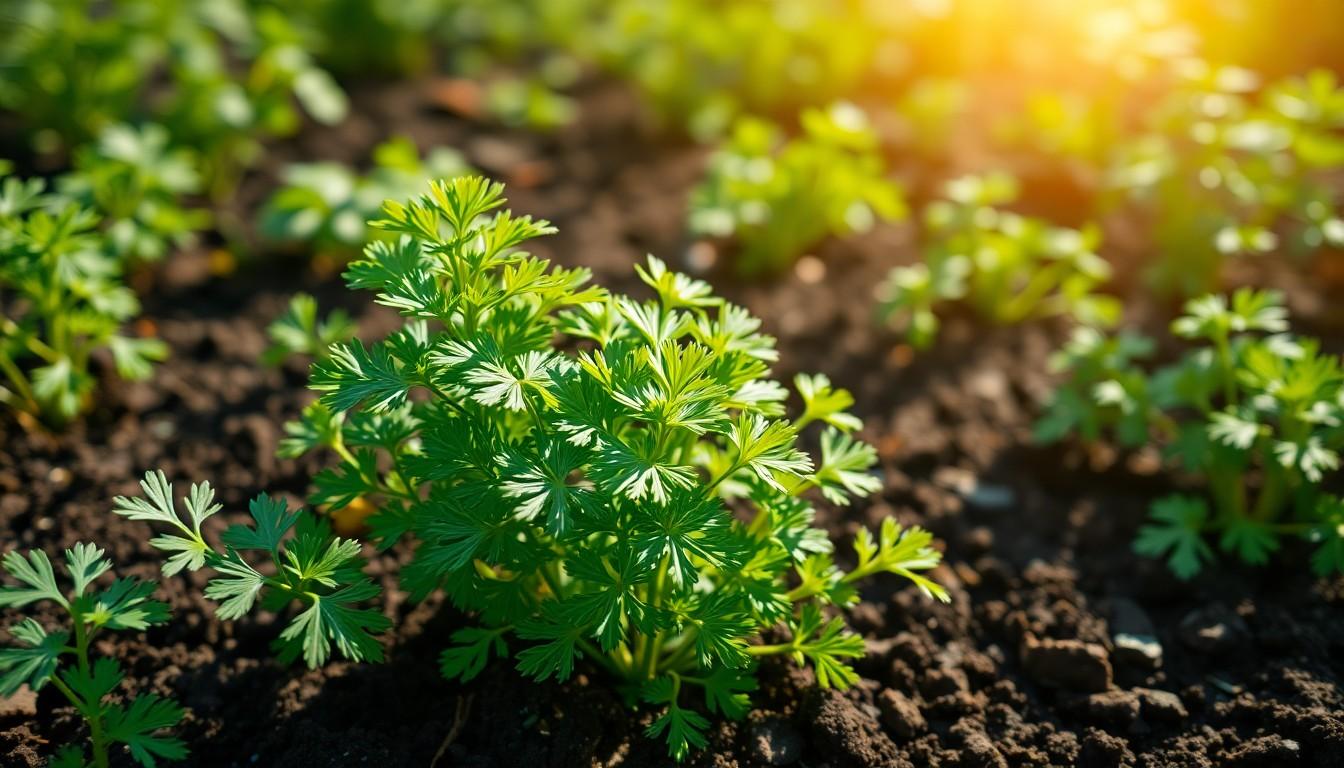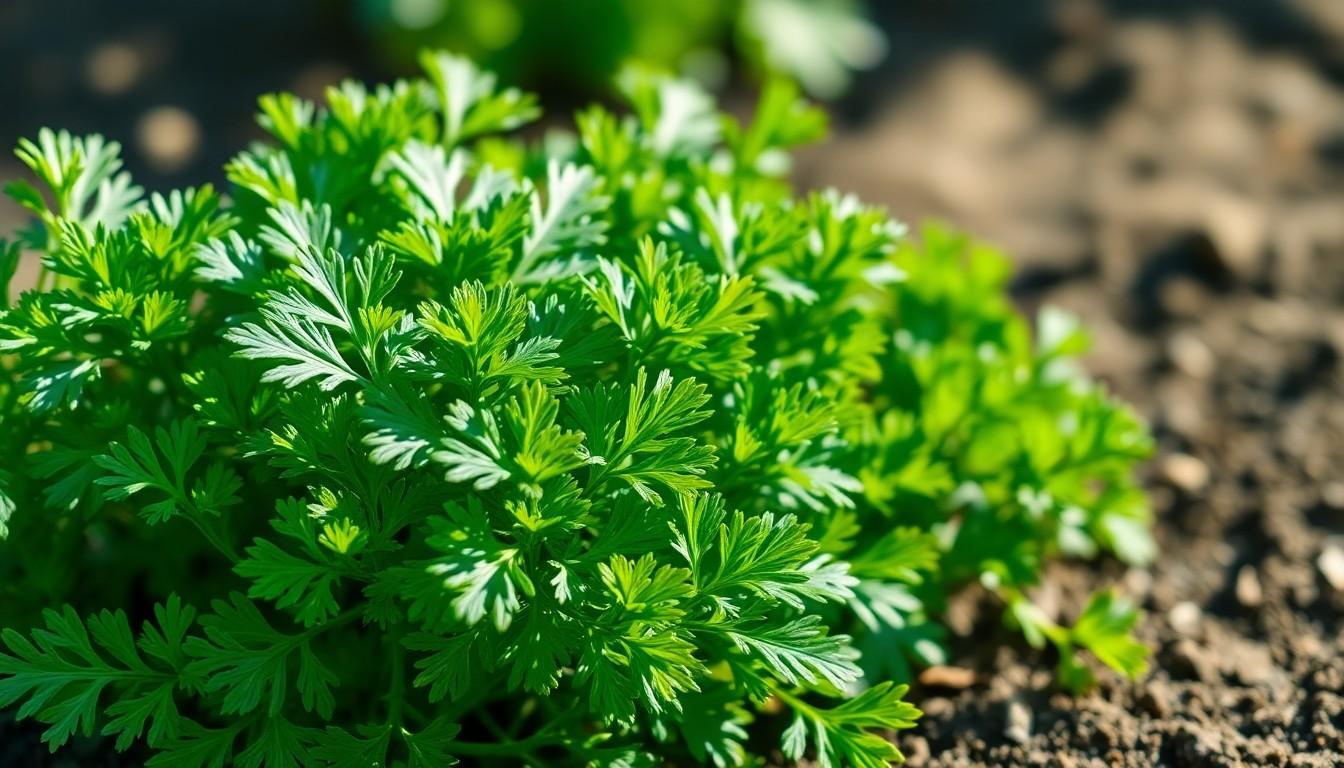If you think parsley is just a garnish, think again! This vibrant herb packs a punch in flavor and nutrition. Whether it’s brightening up a plate or adding a fresh zing to a salad, parsley deserves a spotlight in every kitchen. But before it can dazzle your taste buds, it needs a little TLC.
Overview Of Parsley Plant Care
Parsley requires specific conditions for optimal growth and flavor. Well-drained soil with a pH level between 6.0 and 7.0 supports healthy development. Regular watering is essential; soil should remain moist but not soggy.
Light exposure plays a key role in growth. Parsley thrives in full sun but can tolerate partial shade, particularly in hotter climates. Fertilizing every four to six weeks with a balanced fertilizer promotes robust leaf production and nutrient content.
Pests can hinder parsley growth, making monitoring necessary. Aphids and spider mites often target parsley plants. Organic solutions like insecticidal soap effectively manage infestations while maintaining plant health.
Pruning helps improve air circulation and encourages bushy growth. Snipping off the outer leaves allows for new growth from the center, enhancing the plant’s overall vigor. Harvesting regularly stimulates continuous leaf production, ensuring a steady supply for culinary use.
Overwintering parsley in colder regions can extend its life cycle. Mulching around the base protects roots from extreme temperatures. Alternatively, bringing potted parsley indoors during winter provides a controlled environment for growth.
Using these care strategies ensures parsley plants reach their full flavor potential. Engaging regularly with the plants will yield vibrant greenery and flavors perfect for enhancing any dish.
Essential Growing Conditions

Parsley thrives under specific growing conditions that promote robust health and flavor. Understanding these factors helps nurture the plant effectively.
Light Requirements
Bright, indirect sunlight works best for parsley plants. They require at least six hours of light daily for optimal growth; however, plants can tolerate partial shade. Excessive direct sunlight may lead to scorched leaves. Utilizing grow lights can provide essential light when growing indoors or in less sunny areas. Ensuring even light distribution encourages uniform leaf development, resulting in sturdy and flavorful plants.
Soil Type and pH
Well-drained soil plays a critical role in parsley’s growth. Organic matter-rich soil enhances drainage and nutrient availability. A pH level between 6.0 and 7.0 creates an ideal environment for parsley, promoting healthy development. Amending sandy or clay soils with compost supports better moisture retention and nutrient absorption. Regular testing of soil pH can help maintain the right balance for optimal plant health.
Temperature and Humidity
Temperatures between 70°F and 80°F encourage parsley’s growth during the day; cooler nights between 50°F and 60°F are also beneficial. Parsley plants prefer moderate humidity levels, thriving in environments with around 50% to 70% humidity. Sudden temperature fluctuations might stress the plant, hindering growth. Implementing protection against extreme weather can help maintain a stable environment for parsley, ensuring strong and flavorful leaves.
Watering Guidelines
Proper watering is crucial for parsley plant health. It promotes growth and enhances flavor.
Frequency and Amount
Watering parsley typically occurs every 1 to 2 weeks. The soil should remain consistently moist but not waterlogged. When watering, apply approximately 1 to 1.5 inches of water per week, adjusting based on specific environmental conditions. In hotter climates, increased frequency may be necessary. Checking the top inch of soil helps determine moisture levels. If it feels dry, it’s time to water. Ensuring even moisture supports healthy development.
Signs of Overwatering or Underwatering
Identifying overwatering or underwatering is essential for parsley. Symptoms of overwatering include yellowing leaves and a damp, mushy root system. Foul odors from the soil may also indicate root rot. Conversely, underwatering leads to wilting and brittle leaves. Stunted growth can occur with insufficient moisture. Inspecting the leaves and soil provides clear clues about the plant’s hydration status. Adjusting watering habits based on these signs maintains optimal health.
Fertilization Techniques
Fertilization techniques play a vital role in parsley plant care, helping to ensure vigorous growth and abundant yields. Selecting the right type of fertilizer and knowing when to apply it can optimize nutrient intake.
Types of Fertilizers
Organic fertilizers, such as compost and well-aged manure, enrich soil health while providing essential nutrients. Granular fertilizers offer convenience and consist of balanced N-P-K (nitrogen, phosphorus, potassium) ratios for targeted nutrient application. Liquid fertilizers provide quickly available nutrients and allow for adjustments based on plant needs. Slow-release fertilizers feed plants over an extended period, reducing the frequency of applications. Each fertilizer type enhances parsley growth, promoting lush leaves and robust flavor.
Application Frequency
Fertilizers generally require application every four to six weeks during the growing season. Consistent feeding supports ongoing growth and leaf production. Adjusting frequency may depend on soil quality, with nutrient-poor soils benefiting from more regular applications. Monitoring plant health can also help determine if adjustments are necessary. Recognizing signs of nutrient deficiency, such as yellowing leaves, informs timing for additional feedings. Proper application frequency aligns with parsley’s nutritional needs, ensuring successful growth and culinary value.
Pruning and Harvesting Tips
Pruning and harvesting are integral to parsley plant care. Proper techniques enhance growth and flavor.
Best Practices for Pruning
For optimal growth, prune parsley regularly. Cut stems about one-third from the top to promote bushy growth. Shear off yellowing or damaged leaves to maintain plant health. This practice encourages better air circulation and reduces the risk of diseases. Additionally, prune parsley when it’s around 6 inches tall, ensuring the plant remains vibrant. Performing this task every few weeks helps stimulate new growth, keeping the parsley productive throughout the season.
How to Harvest Parsley
To harvest parsley, use a sharp knife or scissors. Start by snipping off outer leaves, which are mature and ready for use. Leave inner leaves to continue growing. A good rule is to never harvest more than one-third of the plant at once; this prevents shock and promotes ongoing leaf production. Gather parsley in the morning for optimal flavor. Store freshly cut parsley in a glass of water in the fridge to maintain crispness.
Conclusion
Caring for parsley is a rewarding endeavor that enhances both the garden and the kitchen. By providing the right conditions and consistent care, anyone can enjoy a bountiful harvest of this versatile herb.
Regular watering, proper fertilization, and strategic pruning are key to ensuring healthy growth and vibrant flavor. With a little attention to detail, parsley can thrive and become a staple in culinary creations.
Whether it’s used fresh in salads or as a flavor booster in various dishes, parsley’s potential is truly remarkable. Embracing these care techniques will not only yield a thriving plant but also elevate the overall cooking experience.




